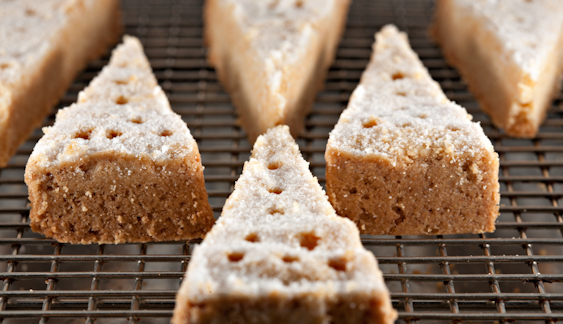Charleston Scotch Cake (Shortbread)

introduction
In The Carolina Housewife, first published in 1847, the recipe for Scotch Cakes is listed just before Portugal Cakes in the section called “Tea Cakes, Etc.” A casual reader might miss the association: in Charleston, teatime was observed for the purpose of tasting great rare, rich, and mostly sweet Madeira estate wines from the islands ruled by Portugal. “Tea” lasted at least an hour, and often two, every day. From a modern perspective, it is difficult to imagine a society in possession of the rarified taste and wealth—not to mention idle time—necessary to take “tea” on a daily basis.
While much of the world affected by British tradition served dainty cakes at tea, Charleston’s “tea” called for texturally assertive accompaniments, and its Scotch cake, an early American version of classic British shortbread, was exactly that. Our recipe for Charleston Scotch cake, better known as shortbread, replaces a portion of wheat flour with Carolina Gold Rice Flour, whose fine granulation resists hydration during baking and dries to create a crisp patina and a delicate crumb with enhanced melting properties. This is a biscuit with gravitas, and a recipe that makes history in distinct and ravishing form.
Baking Notes
Nothing demands more integrity of its ingredients than shortbread. There are only four, so make them count: the flour should be fresh, unbleached, and all-purpose; the sugar should be superfine; the rice flour should come from Anson Mills. But let’s face it: great shortbread is ultimately about butter—the other ingredients are in play to help create a texture that delivers full butter flavor in final cookie form. It follows that the butter be fresh and of highest quality. We favor European butter or domestically produced European-style butter, which has a lower water content and a higher butterfat content than typical supermarket butters and also offers increased elasticity in handling.
equipment mise en place
For this recipe, you will need a digital kitchen scale; a food processor; a 9-inch round cake pan; a small offset spatula; a thin, sharp knife; a long wooden skewer or round toothpick; and a wire cooling rack.
-
-
7.5ounces (1½ cups) unbleached all-purpose flour or an equal amount by weight of Anson Mills Colonial Style Fine Cloth-Bolted Pastry Flour
-
2.5ounces (½ cup) Anson Mills Carolina Gold Rice Flour
-
3.5ounces (½ cup) plus 1 tablespoon superfine sugar
-
½teaspoon fine sea salt
-
5ounces (10 tablespoons) cold unsalted European-style butter, cut into pieces
-
-
Adjust the oven racks to the lower and upper third positions and heat the oven to 325 degrees. Turn the flours, ½ cup sugar, and salt into a food processor bowl and pulse to combine.
-
Distribute the butter over the dry ingredients in the food processor and pulse until the mixture resembles coarse meal. Run the processor without pulsing until the dough is very fine, about 10 seconds more. Turn the mixture into an ungreased 9-inch round cake pan and press down firmly and evenly with a small offset spatula or the back of a spoon to compress and compact the dough. Place the pan on the lower oven rack and bake for 20 minutes.
-
Remove the pan from the oven. Working quickly, score the shortbread into 16 wedges with a thin, sharp knife, and then pierce a design into each wedge with a wooden skewer. (Don’t cut or pierce completely through the cookie’s thickness.) Return the pan to the lower oven rack and bake for 10 minutes more. Transfer the pan to the upper oven rack and continue to bake until the shortbread is toasty brown, 30 to 40 minutes longer. Remove from the oven and set the pan on a wire rack. While the shortbread is still hot and in the pan, sprinkle the 1 tablespoon sugar over the surface and gently cut through the score marks with the knife. Let cool completely. Remove the wedges from the pan with a small offset spatula. Well wrapped, the shortbread will keep for up to 2 weeks at room temperature.
A version of this recipe by the same author, Kay Rentschler, originally appeared in Cook’s Illustrated magazine.